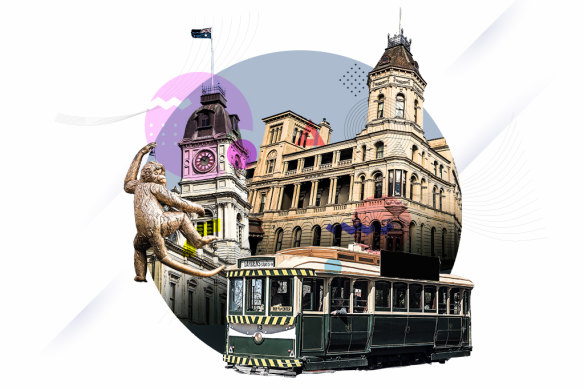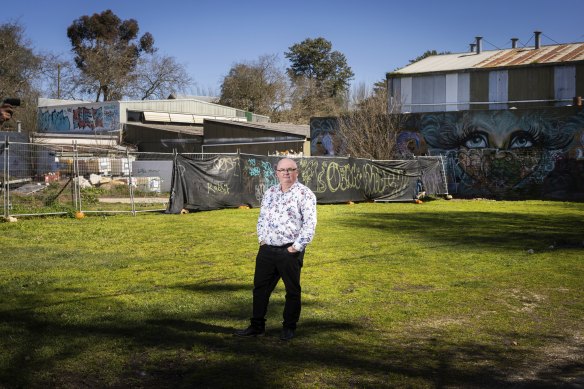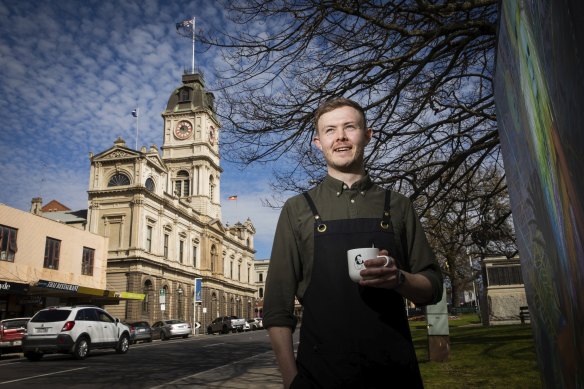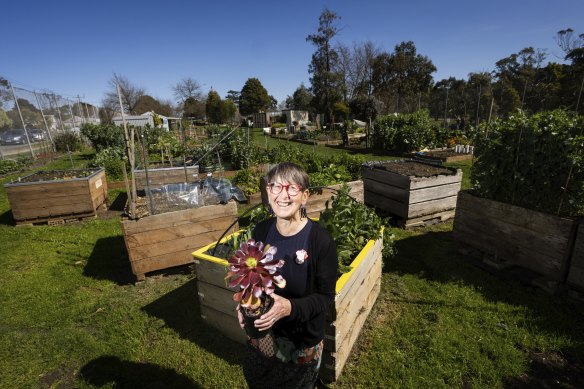By Benjamin Preiss
Many young people are returning to Ballarat to open businesses.Credit: Illustration: Marija Ercegovac
Save articles for later
Add articles to your saved list and come back to them any time.
In 2010, your correspondent spent a year in Ballarat and rented one of those classic three-bedroom period weatherboard houses that have helped define the regional city’s architectural character.
This house, like most others nearby, was a roomy single-storey dwelling on a spacious block.
The local creeks and vast stretches of grassy open space beside the train line gave this suburban pocket of Ballarat East an almost semi-rural feel. Yet, it was less than three kilometres from the city’s CBD.
But this old neighbourhood will look entirely different in coming decades. Ballarat East is among the established suburbs earmarked for greater residential development as the population soars.
Newcomers might look to Ballarat for affordable housing with land. But planners say apartment living is an inevitable part of the city’s future.
Ballarat mayor Des Hudson backs apartment developments.Credit: Paul Jeffers
A short drive from your correspondent’s old house, Ballarat mayor Des Hudson stands on a vacant tract of land with construction fencing erected in the middle of the site. He says this property, beside a large sports oval and close to a train station, could easily accommodate a four or five-storey development providing two-bedroom apartments.
While apartment living is rare in Ballarat, Hudson thinks a few good examples will help it take root.
“All we need is three or four sites done really well.”
In a series focusing on the imminent transformation of Victoria’s regional cities, The Age is exploring how Ballarat, Geelong, Bendigo and Albury-Wodonga will change in the coming decades.
City centre facelift
The City of Ballarat recently released its draft housing strategy that shows the local population is projected to hit 170,000 by 2041. In 2021, the city’s population stood at 115,000.
“This scale and rate of change is unprecedented in Ballarat’s recent history…” the document says.
To accommodate the forecast population boom, Ballarat must create 29,000 homes. Half are expected to be built in undeveloped areas.
Established suburbs of Ballarat East, Ballarat Central, Sebastopol, Wendouree and Alfredton are identified as having the most capacity for change.
Cheaper housing compared to Melbourne is helping lure people to Ballarat, in addition to decent schools and access to health care. Figures supplied by property data firm CoreLogic show Ballarat’s median house price is almost $553,000, compared to that of Melbourne’s outer east, about $914,300.
Although there is no formally declared city centre, council figures show about 600 people live in what it loosely calls the CBD.
By 2050, Hudson hopes three and four-storey terrace style apartment buildings are far more common throughout the city.
Hudson cites figures showing that between 2011 and 2021, one-bedroom dwellings accounted for just 0.7 per cent of new homes added, while two-bedroom units made up 8 per cent. Four-bedroom houses accounted for 57.1 per cent.
Brendan Wrigley has returned to Ballarat to open a cafe, after living in Melbourne and London.Credit: Paul Jeffers
The city’s draft housing strategy says there is enough land to accommodate 10,500 new homes in the existing Ballarat West growth area in addition to space for 7000 dwellings north of the Western Highway.
In the lead-up to the now cancelled Commonwealth Games, the state government had planned to build a temporary village to house athletes at a contaminated sale yards site, despite the Committee for Ballarat urging it to improve housing around the inner city.
The state government says it has invested $120 million in Ballarat as part of its Big Housing Build with 134 homes completed and another 200 under way.
Now, Hudson says the many vacant second floors above shopfronts could be reclaimed for residential growth.
This, he says, would ease car dependence and help preserve green space for agriculture and the environment.
Brendan Wrigley, who opened a cafe in the centre of Ballarat in 2020, hopes this soon becomes a reality.
“Having a greater density of people living in the middle of town – you’ll see those areas come to life a bit more. That can only be a positive.”
Wrigley, 29, grew up in Ballarat and has returned to the city after stints studying in Melbourne and working in London. He says other young people are also coming back to Ballarat and starting businesses – particularly new restaurants, bars and cafes.
RMIT international planning professor Marco Amati says filling out vacant floors above shopfronts may require some unusual council policies for the second-storey properties.
“You could define a few streets where you encourage Airbnb,” he says.
Otherwise, the council could buy the vacant properties, Amati says, and offer them for short-stay or long-term accommodation at discounted rates.
“It’s about pump-priming the CBD, so you get more circulation of people, and you get better overall economic activity.”
The biggest employment industries in Ballarat are healthcare and social assistance, followed by retail, construction and education.
In the city whose goldfields attracted migrants from across the world in the 1850s, gold has continued to be mined in recent years.
But the operators of Ballarat’s major mine, Balmaine Gold, are in administration, and various bidders are seeking to acquire it from administrators.
Minerals Council of Australia executive director James Sorahan expects gold mining to continue in Ballarat beyond 2050.
“There’s still a lot of potential gold deep underground in the whole region,” he says.
Sun, wind and the first renewable city
Committee for Ballarat chief executive Michael Poulton also wants to capitalise on natural resources, but his vision involves the sun and wind. He hopes by 2050, Ballarat will have claimed the title of Australia’s first renewable city — powered entirely by nearby wind farms and rooftop solar panels.
The committee’s plan includes a community-owned retailer that would buy energy from power generators and sell excess electricity into the national grid.
Poulton says many residents might prefer to buy their electricity from a non-profit and locally owned retailer dedicated to community benefit.
The committee also wants to reduce emissions by giving pedestrians and cyclists priority over cars and parking spaces.
Poulton says the CBD’s main drag, Sturt Street, should relinquish a lane of traffic in each direction to make way for bike paths running through the grand median strip. And other main roads should get similar treatment.
“Cities around the world are doing it. Why not Ballarat?”
Poulton wants grassy strips to replace car parking spaces, to make the city more attractive.
‘No dog boxes’, back to the future
By 2050, Rail Futures Institute president John Hearsch expects Ballarat’s population will have grown enough to justify substantial rail upgrades.
The institute is pushing for the resurrection of the Geelong-Ballarat line after the direct passenger service between the cities closed in 1978.
“It doesn’t need that much work to bring it back to the standard where you can run quite a decent passenger service,” he says.
Although trams were decommissioned in Ballarat in the early 1970s, Hearsch insists a light rail system will again be necessary to connect the city centre with surrounding suburbs.
Hudson supports calls for ambitious transport projects, including light rail.
But he says giving over car lanes to bicycles in the city centre would not gain community support.
“We would want to be pretty well assured of the evidence base behind that, and we’re not there yet.”
The state government says the Transport Accident Commission, Department of Transport and Planning and Ballarat council are working to improve pedestrian and bike networks, which includes better links to the city centre.
In 2021, the government also completed the Ballarat line upgrade, delivering 135 new weekly train services.
Hygge Property director Joseph Van Dyk, who worked on the Nightingale apartment buildings in central Ballarat, believes more people are warming to the idea of living car-free.
The Ballarat Nightingale development has an eight-star energy rating and prioritises environmentally friendly and communal living. Hygge is starting work on another apartment project in central Ballarat, which will have 60 dwellings.
Cathy McCallum runs a community garden.Credit: Paul Jeffers
Cathy McCallum, who runs the community garden in Ballarat East, believes new apartment projects like the Nightingale would help shift people’s desire from living in big houses to apartments.
“No dog boxes, no way,” she says. “It’s got to be carefully planned. It’s got be communal.”
McCallum hopes her community garden can provide a welcoming space for apartment dwellers of the future. She wants to install learners’ plots and hold gardening classes.
She knows that profound change is coming, and higher density is necessary as the city prepares to absorb thousands more residents.
“I see we need to do it. But I’d hate to see us end up like Melbourne – just driving and driving through suburbs.”
The Morning Edition newsletter is our guide to the day’s most important and interesting stories, analysis and insights. Sign up here.
Most Viewed in National
Source: Read Full Article






